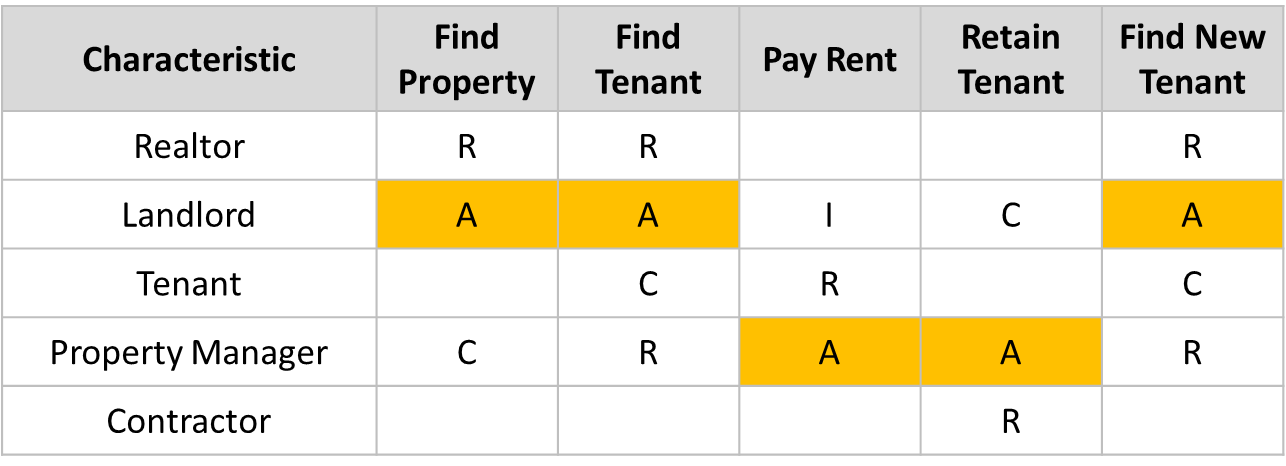Lots of clients, not all the same
Let’s agree that there are a lot of different people on the client side. Some are doing the work, while others are only curious. When you have more than a handful of people involved, it’s very easy to get confused and make incorrect assumptions on who is doing what. Confusion = frustration = lack of adoption = failure.
A successful project has sufficient client input and buy-in (of course). However, it’s not the goal to involve all the client-side people throughout the project. That would be exhausting and nothing would get done. So how to delineate between the different clients and how involved they need to be in the process?
RACI (or RASCI) is an abbreviation for:
- R – Responsible: Who does the work?
- A – Accountable: Who has the final say? Who gets in trouble if it’s not done?
- C – Consulted: Who is smart on this topic, and might be helpful to consult?
- I – Informed: Who needs to be updated? Who might get annoyed if they find out the wrong way?
It’s a simple tool
1) Put all the stakeholders on one side of the table 2) List the activities you need ownership for on the other side 3) Fill in the grid with the letters R, A, C, I. In the end, the grid will be full of letters. Blanks are okay.
- Start with the “A”. The accountable person who is the owner of the process, the person who has to make sure it gets done. They are the “one throat to choke” There can only be 1 accountable person.
- Add in the “R”. The people who will do the hard work of making the change happen. It’s okay to have more than 1. Complex work requires lots of “R”
- Add in “C”, but be selective. If you add too many people to be consulted, it can be a bureaucratic nightmare. The purpose is to drive action, not committees.
- Add in “I”, but these are the least important. Most of these people can be gently informed by email or a status update.
Here is a simple example
If you have a rental property, there are 5 major steps: Find a property, find a tenant, get them to pay rent, keep them as long as possible, and when they leave, find a new tenant. Simple. . . 1, 2, 3, 4, 5.
Even if you are the landlord, you are not doing all the work. Yes, you are “accountable” because you have the final say on the tenant qualifications and rent amount, but you are not doing all the work. See all the people you have who are responsible?
- Realtor is responsible for finding a property, and sometimes, finding a tenant
- Tenant is responsible for paying the rent
- Property manager is responsible for finding the tenant(s)
- The contractor is responsible for fixing the sink, and air conditioner so that the tenant is happy and stays in the rental as long as possible

The “A” is the most important
Sometimes consultants go too far. I have seen some RACI charts that are 15 x 10. . .or 150 boxes. That is crazy. No one can keep up with that. Sometimes it is better to simplify. Just put the “A” and let that person determine the rest of the grid. Let them be the quarterback and set their own team.
Sometimes, it takes a lot of thinking to determine who the “A” is. . .part of the beauty of this tool is it forces you to find that 1 person who is really accountable. Only 1 person.
Make sure you have the right “R”
Think about who is really doing the work. Sometimes you might list more people. . . because the work has to get done. Sometimes, you put the “title” because it is a generic role, but sometimes you put in the specific names. Don’t be shy. This is tool is to drive ownership and action.
There is a blurry line between “C” and “I”
Don’t spend too much time debating who is a C and who is an I. It is enough to know that you have to speak to that person. Sometimes they have good advice for you, sometimes, they don’t.
This stuff works
It drives conversation, and consensus on how the work will be done. It can be laborious at times, but a few good hours making this clear among the executives prevents a lot of confusion in the field. This can really LEAN out inefficiencies and reduce miscommunication.

Thanks for this idea and very informative!
Thank you for reading.
Well written and explained.
Undoubtedly this is one of the most important model in any multi faceted implementation.
Thanks for reading –
Though I have different take on the multiple “R’s”, the reality is that almost all organizations and functions therein have their RACI muddled up. Even after you define a RACI model, the never ending org design / restructure means that RACI changes, and the problems resurface.
Add fuel to fire – hardly anyone in a day-job truly knows what RACI means and how crucial it is define and sustain it.
Completely agree. The old consulting joke,
Q: “What’s the best organizational design?”
A: “I don’t know, but it’s definitely not this one.”
Yes, the big thing ‘A’. Especially in larger companies people either duck out or argue hard for having a big bunch number of accountable people, Even better between different departments. I’ll always bring up the ‘Highlander’ principle – ‘There can be ONLY ONE!’. If you’ve seen the movie, you know what I’m talking about. And then you have to stand your ground to get this one person.
Love it. There can only be one.